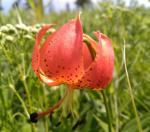In a relatively flat stretch of northern Callaway County in central Missouri, cars zoom by on Interstate 70. On one side of the highway, corn and soybeans grow. On the other, native prairie grasses stretch to the horizon.
That grassland is the University of Missouri’s Tucker Prairie, 146 acres of native prairie that has never been plowed. It is the largest prairie remnant in mid-Missouri.

David Schulz, biological scientist at University of Missouri, says he appreciates the contrast between the modern agriculture next to the wild, native prairie.
“I like that you can look across I-70 and see modern agricultural fields,” he says.
Schulz says the two sides of the interstate show Missouri’s present and its past.
“This is the reality of Missouri, agriculture is what drives the state and feeds the world,” he says.

The native prairie provides a place for wildlife and native plants and, above all, a reminder of the state’s starting point on that long march of agricultural practices. The prairie is used for a variety of purposes, including teaching and research, looking at how soil that has never been tilled or managed compares to soil under different agricultural practices. It is also a place for people to visit and hike and enjoy.
Wild native prairie once covered much of Missouri, but gradually it was tilled under so people could farm the fertile soil or fenced in and reseeded for grazing. But the swath at Tucker Prairie remained. The William C. Tucker family owned it for 125 years, preserving it as a native prairie, eventually selling it to MU in 1957.
“The Tucker family had maintained this plot of land,” Schulz says.
MU prairie ecologist Claire Kucera was instrumental in securing the funding to purchase the native prairie. The university used funds from the National Science Foundation, the Missouri Chapter of the Nature Conservancy and various alumni.
Schulz says having that large of a piece of never-plowed prairie is a special thing.
“It is fairly rare and valuable,” he says. “The value is in being able to understand how plows and tillage might affect soil composition and health for the positive or negative.”
He says it also allows the area to maintain some plant diversity, and the prairie can serve as a source of native seed for people looking to establish native grasses and plants elsewhere.
“We are a source of seed and plants to restore other prairie in the state,” Schulz says.

The Missouri Department of Conservation does a lot of work to manage the prairie, taking care of burn cycles and keeping out invasive species, for example.
The Tucker Prairie soil supports more than 250 species of plants, with big bluestem, little bluestem, Indian grass and prairie dropseed as the dominant species. The prairie has an extensive clay pan that makes tree growth difficult. According to the MDC, this clay pan also restricts drainage, meaning the water table in the winter and spring months is often just a foot below ground in the prairie’s flattest portions. This soil typically becomes fairly dry in the summer and fall.
Flowers bloom at different times of the year, including downy sunflowers and the bright purple of the prairie blazing star.
The department of conservation says the Tucker Prairie is the largest remnant of the “Grand Prairie” that once covered large areas of Missouri.
To visit, go to Exit 144 on I-70, drive south on County Road 223 for 1.5 miles, head left (east) on County Road 220 for one mile, then head left (north) on County Road 215 for 1.5 miles. The entrance is on the left (west) side of the road.
Daily Headlines
Daily Ag News and Market information from across the midwest.
